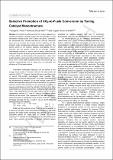COMMUNICATION Selective Promotion of CO₂-to-Fuels Conversion by Tuning Catalyst Mesostructure
Author(s)
Yoon, Youngmin; Hall, Anthony Shoji; Surendranath, Yogesh
DownloadManuscript_Angew_Revisions_Final.pdf (1.105Mb)
OPEN_ACCESS_POLICY
Open Access Policy
Creative Commons Attribution-Noncommercial-Share Alike
Alternative title
Tuning of Silver Catalyst Mesostructure Promotes Selective Carbon Dioxide Conversion into Fuels
Terms of use
Metadata
Show full item recordAbstract
An electrode's performance for catalytic CO₂ conversion to fuels is a complex convolution of surface structure and transport effects. Using well‐defined mesostructured silver inverse opal (Ag‐IO) electrodes, it is demonstrated that mesostructure‐induced transport limitations alone serve to increase the turnover frequency for CO₂ activation per unit area, while simultaneously improving reaction selectivity. The specific activity for catalyzed CO evolution systematically rises by three‐fold and the specific activity for catalyzed H₂ evolution systematically declines by ten‐fold with increasing mesostructural roughness of Ag‐IOs. By exploiting the compounding influence of both of these effects, we demonstrate that mesostructure, rather than surface structure, can be used to tune CO evolution selectivity from less than 5 % to more than 80 %. These results establish electrode mesostructuring as a powerful complementary tool for tuning both catalyst selectivity and efficiency for CO₂ conversion into fuels. Keywords: CO₂ reduction; electrocatalysis; mesoporous materials; mass transport; renewable energy
Date issued
2016-11Department
Massachusetts Institute of Technology. Department of Chemistry; Massachusetts Institute of Technology. Department of Materials Science and EngineeringJournal
Angewandte Chemie International Edition
Publisher
Wiley Blackwell
Citation
Yoon, Youngmin et al. “Tuning of Silver Catalyst Mesostructure Promotes Selective Carbon Dioxide Conversion into Fuels.” Angewandte Chemie International Edition 55, 49 (November 2016): 15282–15286 © 2016 Wiley-VCH Verlag
Version: Original manuscript
ISSN
1433-7851
1521-3773